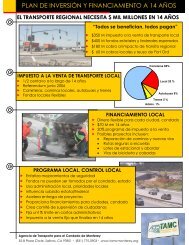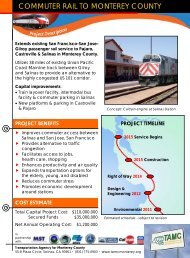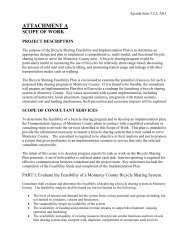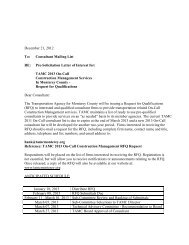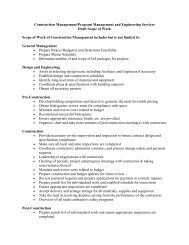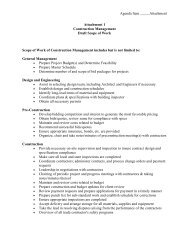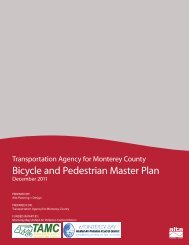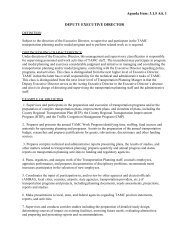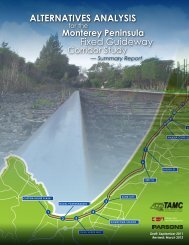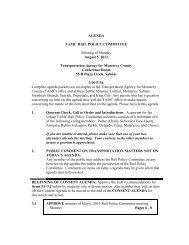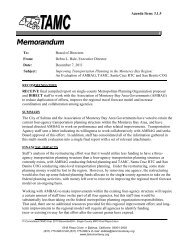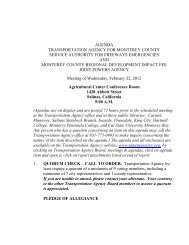156 Toll Road Study and Appendices - Transportation Agency for ...
156 Toll Road Study and Appendices - Transportation Agency for ...
156 Toll Road Study and Appendices - Transportation Agency for ...
- No tags were found...
You also want an ePaper? Increase the reach of your titles
YUMPU automatically turns print PDFs into web optimized ePapers that Google loves.
<strong>Toll</strong>ing Traffic <strong>and</strong> Revenue <strong>Study</strong> Highway <strong>156</strong> CorridorTraffic <strong>and</strong> Revenue AnalysisRevenue SchedulesFinancial feasibility analysis required a toll revenue schedule <strong>for</strong> a 40-year period.Calculation of the revenue schedule requires traffic <strong>for</strong>ecasts on Highway <strong>156</strong> <strong>for</strong> theopening year <strong>for</strong> both Phase 1 (2021) <strong>and</strong> the horizon year (2035) conditions. Theconversion from traffic <strong>for</strong>ecasts to a revenue schedule was dependent on a number ofelements including the revenue schedule start year, the inflation rate, annualization factor,<strong>and</strong> a “ramp-up” factor.Start Year<strong>Toll</strong> revenues are not collected until the construction of Route <strong>156</strong> West Corridor Phase 1has been completed <strong>and</strong> the roadway improvements are opened to traffic. Thus, theopening year is the first year following the end of the construction schedule. This studyassumed the opening year of Phase 1 to be 2021.Creation of Full ScheduleThe <strong>for</strong>ecasting process provided average annual weekday <strong>and</strong> weekend day traffic <strong>and</strong> tollrevenue <strong>for</strong> years 2021 <strong>and</strong> 2035. The financial analysis required toll revenue <strong>for</strong>ecasts <strong>for</strong>all years from project opening in 2021 to the end of the bond repayment period in 2061.Forecasts of revenue <strong>for</strong> years from 2022 to 2034 were derived by linear interpolation ofthe 2021 <strong>and</strong> 2035 <strong>for</strong>ecasts.The plan to use all-electronic, open road toll (ORT) collection requires special considerationin the revenue analysis. Implementation of ORT would likely have two major impacts ongross toll revenue. First, because of its cashless nature <strong>and</strong> the associated privacy issuesperceived by some, a minority of travelers will chose not to use an ORT system. Second,complete ORT systems incur unreadable video images <strong>and</strong> have higher occurrences ofuncollectible accounts. This study accounts <strong>for</strong> these effect <strong>and</strong> assumed a 5% reduction intoll facility traffic to reflect the privacy issue, <strong>and</strong> an additional 5% reduction in grossrevenue to account <strong>for</strong> unreadable video images <strong>and</strong> uncollectible accounts.Inflation RateAll monetary elements (travel costs, <strong>and</strong> value of time) of the <strong>for</strong>ecasts use year 2012dollars, but the financial model needs revenues in the year of accrual. Year 2012 dollarswere inflated at a rate of 2.5% to yield year of accrual dollars.<strong>Toll</strong> IncreasesThis study assumes that tolls increase annually with inflation, assuming a traditional publicsector financing, <strong>and</strong> is appropriate <strong>for</strong> a sketch analysis. Also, since toll collection will beimplemented completely using ORT, frequent toll rate adjustments are practical.Accordingly toll rates were converted to year of accrual by applying a toll inflation rate of2.5% annually.16



